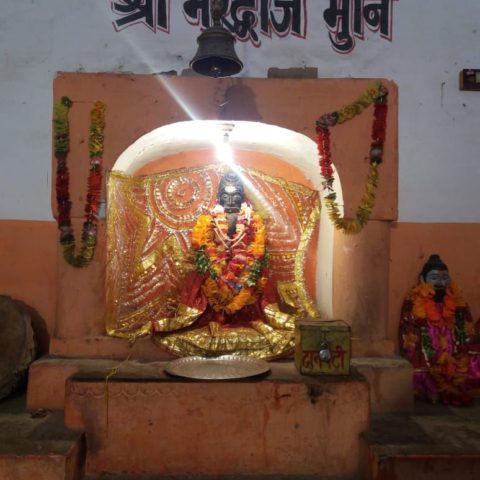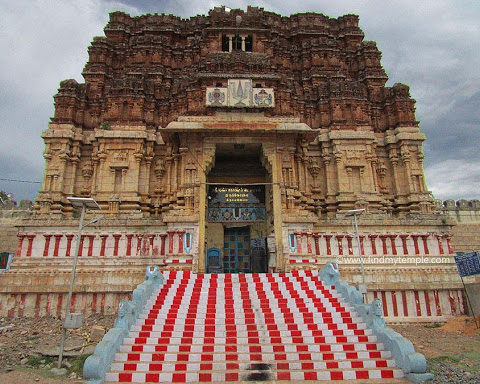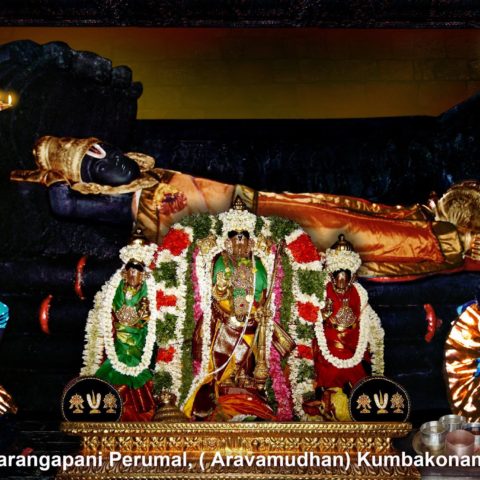
Govardhana Hill is situated in Vraja Mandala or Vrajabhumi. Although Lord Krishna grew up across Vraja Mandala, He performed innumerable lilas on Govardhana, including the celebrated Govardhana-lila.
An important occurrence, described in the Srimad Bhagavata Purana, narrates Lord Krishna’s lifting the Govardhana Hill. Every year, devotees from all over the world throng to Vraja Mandala and circumambulate the sacred Hill.
The appearance of Govardhana Hill
According to the Garga-samhita, Govardhana Hill is the beloved son of Dronachala – the king of mountains. In the Satya Yuga, Pulastya Muni was looking for a holy place to perform his sacrifices; hence approached Dronachala and asked him for his son Govardhana for sacrifices.
Dronachala was reluctant to part with his favorite son. Govardhana agrees to accompany the sage, as he did not want his father to be cursed by the powerful sage. A condition was laid by Govardhana, that wherever the sage would put him down, he would remain there. Pulastya Muni took Govardhana and started for his ashram.
While passing over Vraja Mandala, Govardhana becomes enamored by the beauty of the place and decides to reside there. To fulfil his desire, Govardhana uses his mystic powers and makes the sage feel the urge to answer nature’s call. The sage was forced to place the mountain down. On returning, he found that he could not move Govardhana being very heavy. The disappointed sage realizes the trickery of Govardhana. He cursed Govardhana to shrink by the size of a sesame seed daily.
Govardhana Hill was originally 115 kms long, 72 kms wide and 29 kms high and now the hill is only 80 feet tall at its highest point.
Govardhana Hill is non-different from Lord Krishna
Krishna declared that Govardhana Hill is His expansion. Krishna began the Govardhana Parikrama as process to worship this transcendental hill. Devotees circumambulate the twenty-one kms Govardhana Hill to pay their respects to Lord Krishna during the pilgrimage to the Vraja Mandala. It ideally takes approximately 8 hours to complete the circumambulation by foot and about 2 hours by road. Some devotees even circumambulate the hill by offering their obeisance at every step to avoid stamping the hill which takes a few days to complete. During the auspicious month of Karthika, millions of devotees circumambulate the Hill.
Govardhana Lila
When Krishna noticed the Vrajavasis making the necessary arrangements for Indra-yajna (a conventional ritual to satisfy Indra, the chief-of-demigods, also responsible for supplying rainfall), He recommended that they give up the worship of Indra and instead worship Govardhana Hill which was providing all fodder for the cows and vegetation for the Vrajavasis.
When Indra realized, the yajna which was to be performed by the cowherd men in Vrindavana had been barred by Krishna, he became enraged. He ordered Samavartaka – the cloud of devastation to go over Vrindavana and submerge the whole area with a massive downpour.
To safeguard Vrajavasis from the torrential rains, Krishna lifted the Govardhana Hill on His left hand’s little finger as lightly as a baby uproots a mushroom from the ground. The rainstorm continued for 7 days and 7 nights. Riding on his elephant Airavata, Indra personally came to punish the inhabitants of Vrindavana.
Indra was dumbfounded to see the 7-year-old boy Krishna holding the Govardhana Hill on His little finger and safeguarding Vrindavana from the dreadful rainfall. He immediately called for all the clouds and asked them to desist. The sky became fully clear of all clouds and the sun shone again. All the denizens of Vrindavana came out and Krishna placed the Govardhana Hill in its place.
Indra became mindful of his offense to Krishna; therefore, he silently appeared before Him and immediately surrendered at the lotus feet of Krishna and offered his prayers.
Govardhana Hill is the pivot of Krishna’s lilas
Lord Sri Krishna performed various lilas in and around the Govardhana Hill. This sacred mountain still houses the holy spots where Krishna performed several lilas like playing, tax collection from Gopis, bringing Ganga from His mind to lifting the entire hill to protect the inhabitants of Vrajabhumi. The following are a few holy spots connected to the lilas performed by Lord Krishna:
Mansi Ganga
This is the starting point of Govardhana Parikrama and the spot where Krishna brought the Ganges from His mind. One Nanda Maharaja wanted to visit Ganga for taking a holy dip. As he was aged, Krishna forbade him to take up this pilgrimage. Krishna brought him here and manifested Ganga from His mind. Hence the beautiful place is known as Manasi-ganga.
Radha Kunda and Shyam Kunda
These two ponds are considered as the most sacred ponds in the entire universe. Radha Kunda was created by Radharani and it is her favorite pond. Every afternoon Radha and Krishna visit this place and perform the jala-krida lila. Govardhana parikrama is incomplete without a holy dip in Radha Kunda.
Kusum Sarovar – A dip in this Kunda awards pure love for Krishna
Kusum Sarovar is a major landmark in the Govardhana Hill. Here Srimati Radharani used to pick up flowers and spend time along with Her sakhis (friends) and so did Lord Krishna at the banks of this lake. One who takes bath in the cooling waters of this lake attains the pure love of Krishna.
How to Reach
The best way to visit Govardhana Hill and relish the lilas of Krishna for a lifetime memory, is to join our Vrajabhumi Yatra. For bookings call 9844700850
Govardhana Hill is well connected with major cities of India.
By Road: The Hill is well connected by road networks. There are regular bus services from Delhi, Agra and Jaipur. You may also book a cab at 9844700850.
By Air: The closest airport is Indira Gandhi International Airport, which is 170 Kms away from the temple.
By Train: The nearest railway station to Govardhana Hill is Mathura Junction which is about 24 Kms away from the temple.
4













4 Comments On Govardhana Hill
Raj Melwani
Pray that you be blessed for introducing us to our culture. We all are not blessed with health and wealth so we cannot undertake physically these yatras .Reading about them feels that not in body but mind we are there.
Thank you Sir.
Deena Bandhu
In Garga Samhita the Sanskrit is til which means sesame seed not mustard seed.
Dear Deena Bandhu Prabhu. Thank you for the correction. Ys, Agrani Krishna Dasa
Gagan
Thank you for a wonderful story and narration. I could feel myself as witnessing it live